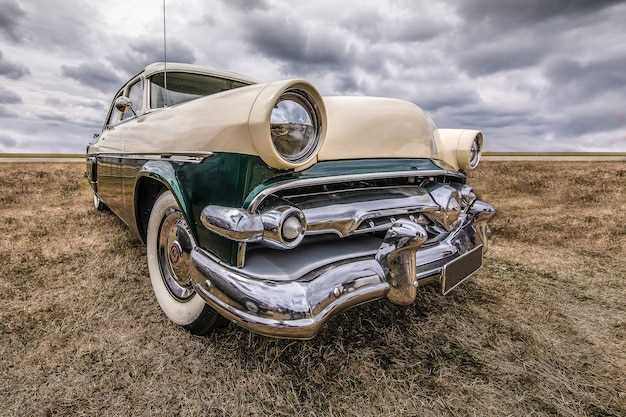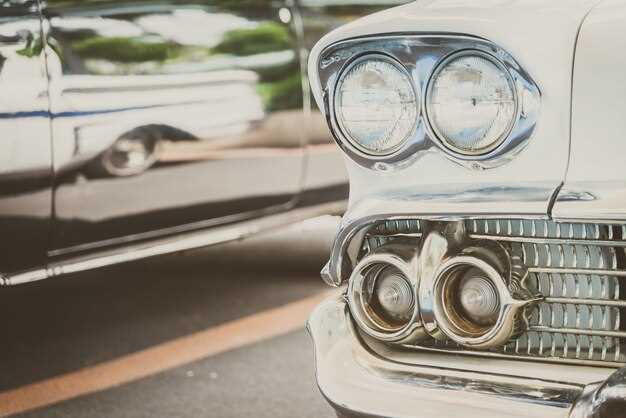
The 1960s were a transformative period for the American automotive industry, giving rise to a unique breed of vehicles known as muscle cars. Characterized by their powerful engines and aggressive styling, these cars embodied the spirit of freedom and rebellion that defined the era. As American youth sought more than just transportation, the muscle car became a symbol of personal expression and performance, making a significant impact on the culture of the time.
In the post-World War II economy, automotive manufacturers began to innovate and cater to a growing market of young consumers who demanded higher speeds and more thrilling driving experiences. The integration of V8 engines into midsize vehicles marked a significant shift, allowing manufacturers to produce cars that were not only fast but also affordable. This intersection of power and accessibility is what truly birthed the muscle car phenomenon.
Among the most iconic muscle cars that emerged during this decade were models like the Pontiac GTO, Ford Mustang, and Chevrolet Camaro. These vehicles didn’t just dominate the streets; they also became vital players in the burgeoning drag racing scene. As the popularity of muscle cars spread, so too did a culture that celebrated speed and performance, forever changing the landscape of American automotive history.
The Birth of the Muscle Car: Key Models and Innovations

The muscle car phenomenon emerged in the 1960s as a distinct segment of the American automotive market, characterized by powerful engines, lightweight bodies, and aggressive styling. This era marked a shift in consumer preferences towards high-performance vehicles that combined speed with affordability, dramatically changing the landscape of American car culture.
One of the seminal models in the muscle car category was the 1964 Pontiac GTO. Often credited with defining the genre, the GTO featured a robust V8 engine that offered outstanding horsepower. Its introduction catalyzed the competition among automakers and spurred the development of similar vehicles, establishing a trend that would dominate the decade.
The Ford Mustang, launched in 1964, further revolutionized the muscle car scene by blending performance with a sporty design, appealing to a broader audience. Its variety of engine options allowed buyers to choose a model that matched their desired level of power and style, solidifying its status as an iconic American car.
In parallel, the Chevrolet Camaro debuted in 1966 as a direct rival to the Mustang, showcasing innovations such as a redesigned chassis and a range of powerful engines. This model quickly became synonymous with muscle, embodying the raw performance and performance-oriented engineering that defined the era.
Technological advancements during the 1960s also contributed to the muscle car revolution. Innovations such as the introduction of big-block engines, lightweight materials, and improved suspension systems allowed cars to achieve greater speeds and enhanced handling. The use of high-compression engines enabled manufacturers to develop models that delivered exhilarating acceleration, further fueling the muscle car craze.
The decade was not just about performance; it also embraced a cultural movement. Cars like the Dodge Charger and Plymouth Barracuda became symbols of freedom and rebellion, reflecting the spirit of the times. The combination of speed, aesthetics, and cultural significance solidified the muscle car’s place in American history.
Market Demands: The Shift in Consumer Preferences during the 1960s
During the 1960s, a significant transformation occurred in the automotive market, driven by changing consumer preferences. American buyers increasingly sought vehicles that offered not only utility but also performance and style. This shift marked the rise of the muscle car, a category defined by powerful engines, aggressive styling, and relatively affordable pricing.
The post-war economic boom enabled a larger segment of the population to experience car ownership, leading to heightened demand for performance-oriented vehicles. As a result, manufacturers began to recognize the potential of a new demographic: young, thrill-seeking drivers looking for excitement behind the wheel. This market trend fueled the development of cars that combined high horsepower with sporty aesthetics.
Iconic models like the Ford Mustang, Chevrolet Camaro, and Pontiac GTO emerged as symbols of this new automotive culture. These vehicles offered features that catered to the desires of consumers, including powerful V8 engines, lightweight designs, and distinctive styling. Advertisements began to highlight not just the cars’ technical specifications, but also the feelings of freedom and rebellion they evoked.
In parallel, the music and youth culture of the 1960s played a crucial role in shaping consumer preferences. As rock and roll flourished, the connection between music, lifestyle, and the automobile became more pronounced. The muscle car represented a sense of identity and self-expression, which resonated deeply with the changing attitudes of a generation.
The 1960s also saw the emergence of high-performance variants of already popular models. Automakers recognized that consumers were willing to pay a premium for speed and flair, prompting competition among manufacturers to create the fastest, most powerful muscle cars. This led to innovations in engine technology and performance enhancements that would define the segment for years to come.
This decade marked a pivotal moment in automotive history, as muscle cars became a dominant force in the market. The blend of performance, price, and personal expression appealed to a wide audience, setting the foundation for the muscle car phenomenon that would continue into the following decades.
Impact of Motorsports on Muscle Car Development
The rise of muscle cars in the United States during the 1960s and early 1970s can be closely linked to the influence of motorsports. As American car manufacturers sought to compete in various racing events, they began to emphasize performance and power in their vehicle designs. The need for speed and agility on the track drove engineers to create high-performance engines that would later define the muscle car era.
Many iconic muscle cars were born from the desire to dominate in races. For instance, the Ford Mustang, introduced in 1964, drew inspiration from the racing successes of its predecessors. The competitive atmosphere created by events like NASCAR and drag racing propelled automakers to push the boundaries of engineering and innovation. This led to the development of powerful V8 engines, lightweight frames, and aggressive styling, all of which became hallmarks of the muscle car genre.
Moreover, successful performances in motorsport not only demonstrated the capabilities of these vehicles but also created a desire among consumers for cars that offered both street and track performance. Manufacturers recognized this demand and marketed their muscle cars not just as transportation, but as embodiments of speed, power, and Americana.
The direct correlation between racing achievements and car sales also prompted car companies to form partnerships with racing teams. These collaborations allowed for the exchange of knowledge that directly influenced the design and performance enhancements seen in subsequent muscle car models. As enthusiasts emulated these racing legends, the muscle car became a symbol of freedom and power on American roads.
In conclusion, the impact of motorsports on muscle car development is profound. The competitive spirit of racing inspired innovations that shaped the history of American cars, creating a lasting legacy that resonates with automotive enthusiasts to this day.
Cultural Influence: Muscle Cars in Music and Movies
The 1960s marked a transformative period for American car culture, with muscle cars becoming icons of freedom and power. This phenomenon closely intertwined with the music and film industries, forever altering their landscapes. Artists and filmmakers began to recognize the allure of these vehicles, which represented not just a mode of transportation but a lifestyle and an attitude.
In music, the emergence of rock and roll coincided with the rise of muscle cars. Songs like “Little Deuce Coupe” by The Beach Boys celebrated high-performance automobiles, framing them as symbols of youth and rebellion. The exhilarating sound of roaring engines was complemented by energetic rhythms, creating a compelling connection between the two forms of entertainment.
Movies of the 1960s also played a crucial role in popularizing muscle cars. Films like “Bullitt” and “American Graffiti” showcased thrilling car chases and the vibrant culture surrounding these powerful machines. Steve McQueen’s iconic portrayal of a tough cop in “Bullitt” solidified the Ford Mustang’s status as a cultural icon, while “American Graffiti” highlighted the social scene of cruising, bringing together car enthusiasts and showcasing muscle cars as central characters in the narrative.
The fusion of music and movies during this era helped to elevate muscle cars beyond mere automobiles; they became symbols of an entire generation’s aspirations and freedom. This blending of cultural mediums solidified the muscle car phenomenon as a lasting influence on American society and its artistic expression.
The Role of Advertising in Popularizing Muscle Cars

The rise of muscle cars in the 1960s can be closely attributed to innovative advertising strategies employed by automobile manufacturers. These vehicles, characterized by their powerful engines and distinctive styling, quickly captured the imagination of the American public. Advertising played a crucial role in shaping the public perception and desirability of muscle cars.
In the 1960s, car companies such as Ford, Chevrolet, and Dodge launched extensive marketing campaigns that highlighted the performance and speed of their muscle cars. They utilized various media, including television, print, and radio, to reach a broad audience. The messaging was often centered around the freedom, power, and excitement that driving these cars could provide, appealing directly to the youthful and adventurous spirit of the era.
Particularly notable was the use of catchy slogans and memorable commercials. Advertisements often showcased cars in action, speeding along picturesque highways or racing on tracks, creating an image of thrill and adventure. The “muscle” aspect of these vehicles was emphasized, reinforcing their performance capabilities and engineering excellence. This approach resonated with consumers looking for more than just transportation; they sought an experience.
Additionally, the association of muscle cars with popular culture played a significant role in their advertising success. Movies, music, and television shows of the time often featured these vehicles, which further embedded them into the American lifestyle. Brands recognized this connection and capitalized on it, using celebrities and influencers to endorse their models, which helped them reach an even wider audience.
| Manufacturer | Popular Model | Key Advertising Strategy |
|---|---|---|
| Ford | Ford Mustang | Appealed to youth culture and freedom |
| Chevrolet | Chevelle SS | Highlighted speed and performance advantages |
| Dodge | Dodge Charger | Utilized race imagery and powerful visuals |
Through strategic advertising, manufacturers not only sold cars but also a lifestyle. The combination of powerful imagery, energetic messaging, and cultural relevance helped establish muscle cars as a symbol of American pride and individuality during the tumultuous decade of the 1960s. This phenomenon set the stage for a lasting legacy that continues to influence car culture and marketing to this day.
Legacy of the 1960s Muscle Cars: How They Shaped Future Generations
The 1960s marked a pivotal era in automotive history, most notably defined by the emergence of muscle cars. These vehicles combined powerful engines with stylish designs, capturing the spirit of American culture and performance.
The legacy of 1960s muscle cars is seen in several key areas:
- Performance Standards: The muscle cars of the 1960s set new benchmarks for speed and power. Models like the Ford Mustang, Chevrolet Camaro, and Dodge Charger showcased V8 engines capable of impressive horsepower, influencing manufacturers to continuously push the limits of automotive engineering.
- Design Influence: The bold aesthetics of muscle cars from the 1960s introduced a new language of design. The long hoods and short decks became a staple that continues to inspire modern sports cars, demonstrating a blend of form and function.
- Cultural Impact: Muscle cars became symbols of freedom and rebellion, embodying the youth culture of the 1960s. They appeared in films, music, and literature, creating an enduring connection between automobiles and personal expression.
- Market Evolution: The success of these vehicles led to the establishment of a new segment within the automotive market. This category of performance-driven cars influences car manufacturing and marketing strategies to this day. Automakers recognize the enduring appeal of muscle cars, often reviving classic models with modern technology.
Moreover, the history of the 1960s muscle cars laid the groundwork for future automotive innovations. Their emphasis on high performance inspired advancements in engineering, safety features, and emissions technology, shaping the future of the entire automobile industry.
As a result, the muscle car phenomenon not only transformed the landscape of American automotive design in the 1960s but also left an indelible mark on subsequent generations, ensuring that the legacy of power and style continues to thrive in contemporary vehicles.



